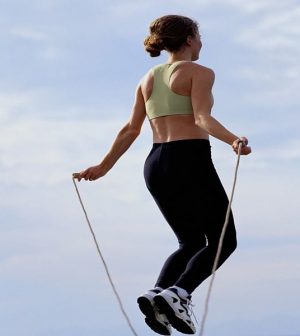- Skip Storing This Everyday Product in the Fridge Door
- Green Tea + B3 Pairing May Boost Brain Health
- Navigating Your Midlife Crisis: Embracing New Possibilities
- City Raccoons Showing Signs of Domestication
- Mapping the Exposome: Science Broadens Focus to Environmental Disease Triggers
- One Week Less on Social Media Linked to Better Mental Health
- Your Brain Changes in Stages as You Age, Study Finds
- Some Suicide Victims Show No Typical Warning Signs, Study Finds
- ByHeart Formula Faces Lawsuits After Babies Sickened With Botulism
- Switch to Vegan Diet Could Cut Your Greenhouse Gas Emissions in Half
Jump Into Plyometrics — the Exercises to Power Muscles

Plyometrics isn’t a new technique, but it’s getting renewed attention because of its value as a training tool, the American Council on Exercise explains.
Its original name, jump training, describes its focus. Movements are similar to those used in downhill skiing, basketball and even tennis. So it’s a great way to train for those sports, but almost anyone can benefit.
One caveat though: plyometrics is a type of exercise that isn’t for people who are currently out of shape or have orthopedic issues.
Plyometrics uses simple exercises like hops and jumps that alter your muscles’ cycle of lengthening and shortening to increase their power. Jumps should always begin from ground level, from and onto cushioned surfaces for both ease and safety. Jumping on and off a low box or over cones or foam barriers are all simple options.
Low-impact landings are key. Land from toe to heel, use the entire length of your feet as rockers to help disperse the force of the landing, and keep knees from swaying to better distribute that force through the muscles that protect these joints. The experts at the American Council on Exercise suggest visualization to lighten your landings: Picture yourself landing like a feather or springing back easily like a coil.
Under the right supervision, youngsters and teens can benefit from plyometrics training, according to the American College of Sports Medicine. It may help strengthen bones, keep kids at a healthy weight, and decrease sports-related injuries, especially for girls who are at higher risk than boys. Common childhood pastimes like hopscotch, jumping rope and jumping jacks are actually all examples of plyometrics.
Because of its explosive nature and very specific movements, instruction makes sense at every age. Also, as with strength training, allow 48 to 72 hours between sessions to give muscles time to recover.
More information
The American Council on Exercise has more on how to use plyometrics safely.
Source: HealthDay
Copyright © 2025 HealthDay. All rights reserved.










